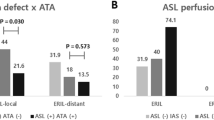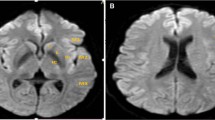Abstract
Objectives
To evaluate the ability of arterial spin labelling perfusion-weighted imaging (ASL-PWI) to identify reperfusion status and to predict the early neurological outcome of acute ischaemic stroke patients after intra-arterial (IA) thrombectomy.
Methods
A total of 51 acute ischaemic stroke patients who underwent IA thrombectomy were retrospectively reviewed. Asymmetrical index before and after IA thrombectomy (AICBFpre and AICBFpost) and volume ratio of the reperfused territory to the baseline perfusion abnormality (reperfusion volume ratio) were calculated on ASL-PWI. A paired t-test was used to compare AICBFpre and AICBFpost. Pearson correlation and multiple linear regression were performed to evaluate correlations between the imaging parameters and NIHSS scores.
Results
Mean AICBFpost was significantly higher than mean AICBFpre (0.923±0.352 vs. 0.312±0.191, p<0.001). AICBFpre had a significant correlation with NIHSSpre (pr=–0.430, p=.004). ∆AICBF had significant correlations with NIHSS24 h, NIHSS5-7 days and ∆NIHSS5-7 days (r=–0.356, p=0.028; r=–0.597, p<0.001; r=–0.346, p=0.033, respectively). ∆AICBF, reperfusion volume ratio and baseline infarct volume were significant independent predictors for NIHSS5-7 days.
Conclusions
ASL-PWI has the potential to serve as a non-invasive imaging tool to monitor the reperfusion status and predict the early neurological outcome of acute ischaemic stroke patients after IA thrombectomy.
Key Points
• CBF change on ASL-PWI after IA thrombectomy correlated with NIHSS scores.
• ASL-PWI can non-invasively monitor reperfusion in AIS patients after IA thrombectomy.
• ASL-PWI may predict early outcome of AIS patients after IA thrombectomy.




Similar content being viewed by others
Abbreviations
- 3D:
-
Three-dimensional
- AICBF:
-
Asymmetrical index of cerebral blood flow
- AIS:
-
Acute ischaemic stroke
- ASL-PWI:
-
Arterial spin labelling perfusion-weighted imaging
- ASPECTS:
-
Alberta Stroke Program Early CT Score
- CBF:
-
Cerebral blood flow
- DSC-PWI:
-
Dynamic susceptibility contrast-enhanced perfusion-weighted imaging
- DWI:
-
Diffusion-weighted imaging
- FLAIR:
-
Fluid-attenuated inversion recovery
- IA:
-
Intra-arterial
- ICA:
-
Internal carotid artery
- IQR:
-
Interquartile range
- mTICI:
-
Modified Treatment in Cerebral Ischemia Scale
- NIHSS:
-
National Institutes of Health Stroke Scale
- ROI:
-
Region of interest
- SWI:
-
Susceptibility-weighted imaging
- TOF:
-
Time-of-flight
References
Berkhemer OA, Fransen PS, Beumer D et al (2015) A randomized trial of intraarterial treatment for acute ischemic stroke. N Engl J Med 372:11–20
Campbell BC, Mitchell PJ, Kleinig TJ et al (2015) Endovascular therapy for ischemic stroke with perfusion-imaging selection. N Engl J Med 372:1009–1018
Goyal M, Demchuk AM, Menon BK et al (2015) Randomized assessment of rapid endovascular treatment of ischemic stroke. N Engl J Med 372:1019–1030
Jovin TG, Chamorro A, Cobo E et al (2015) Thrombectomy within 8 hours after symptom onset in ischemic stroke. N Engl J Med 372:2296–2306
Saver JL, Goyal M, Bonafe A et al (2015) Stent-retriever thrombectomy after intravenous t-PA vs. t-PA alone in stroke. N Engl J Med 372:2285–2295
Soares BP, Tong E, Hom J et al (2010) Reperfusion is a more accurate predictor of follow-up infarct volume than recanalization: a proof of concept using CT in acute ischemic stroke patients. Stroke 41:e34–e40
Tomsick T, Broderick J, Carrozella J et al (2008) Revascularization results in the Interventional Management of Stroke II trial. AJNR Am J Neuroradiol 29:582–587
Zaidat OO, Yoo AJ, Khatri P et al (2013) Recommendations on angiographic revascularization grading standards for acute ischemic stroke: a consensus statement. Stroke 44:2650–2663
Steketee RM, Bron EE, Meijboom R et al (2016) Early-stage differentiation between presenile Alzheimer's disease and frontotemporal dementia using arterial spin labeling MRI. Eur Radiol 26:244–253
Kato H, Kanematsu M, Watanabe H et al (2015) Perfusion imaging of parotid gland tumours: usefulness of arterial spin labeling for differentiating Warthin's tumours. Eur Radiol 25:3247–3254
Alsop DC, Detre JA, Golay X et al (2015) Recommended implementation of arterial spin-labeled perfusion MRI for clinical applications: A consensus of the ISMRM perfusion study group and the European consortium for ASL in dementia. Magn Reson Med 73:102–116
Detre JA, Leigh JS, Williams DS, Koretsky AP (1992) Perfusion imaging. Magn Reson Med 23:37–45
Dixon WT, Du LN, Faul DD, Gado M, Rossnick S (1986) Projection angiograms of blood labeled by adiabatic fast passage. Magn Reson Med 3:454–462
Kanematsu M, Goshima S, Miyoshi T et al (2014) Whole-body CT angiography with low tube voltage and low-concentration contrast material to reduce radiation dose and iodine load. AJR Am J Roentgenol 202:W106–W116
Noguchi T, Yoshiura T, Hiwatashi A et al (2008) Perfusion imaging of brain tumors using arterial spin-labeling: correlation with histopathologic vascular density. AJNR Am J Neuroradiol 29:688–693
Yoo RE, Yun TJ, Rhim JH et al (2015) Bright vessel appearance on arterial spin labeling MRI for localizing arterial occlusion in acute ischemic stroke. Stroke 46:564–567
Okazaki S, Griebe M, Gregori J et al (2016) Prediction of Early Reperfusion From Repeated Arterial Spin Labeling Perfusion Magnetic Resonance Imaging During Intravenous Thrombolysis. Stroke 47:247–250
Yoo RE, Choi SH, Cho HR et al (2013) Tumor blood flow from arterial spin labeling perfusion MRI: a key parameter in distinguishing high-grade gliomas from primary cerebral lymphomas, and in predicting genetic biomarkers in high-grade gliomas. J Magn Reson Imaging 38:852–860
Wahlgren N, Moreira T, Michel P et al (2016) Mechanical thrombectomy in acute ischemic stroke: Consensus statement by ESO-Karolinska Stroke Update 2014/2015, supported by ESO, ESMINT, ESNR and EAN. Int J Stroke 11:134–147
Bokkers RP, Hernandez DA, Merino JG et al (2012) Whole-brain arterial spin labeling perfusion MRI in patients with acute stroke. Stroke 43:1290–1294
Nael K, Meshksar A, Liebeskind DS et al (2013) Periprocedural arterial spin labeling and dynamic susceptibility contrast perfusion in detection of cerebral blood flow in patients with acute ischemic syndrome. Stroke 44:664–670
Wang DJ, Alger JR, Qiao JX et al (2012) The value of arterial spin-labeled perfusion imaging in acute ischemic stroke: comparison with dynamic susceptibility contrast-enhanced MRI. Stroke 43:1018–1024
Zaharchuk G, El Mogy IS, Fischbein NJ, Albers GW (2012) Comparison of arterial spin labeling and bolus perfusion-weighted imaging for detecting mismatch in acute stroke. Stroke 43:1843–1848
Yu S, Ma SJ, Liebeskind DS et al (2017) ASPECTS-based reperfusion status on arterial spin labeling is associated with clinical outcome in acute ischemic stroke patients. J Cereb Blood Flow Metab. https://doi.org/10.1177/0271678X17697339:271678X17697339
Suh SH, Cloft HJ, Fugate JE, Rabinstein AA, Liebeskind DS, Kallmes DF (2013) Clarifying differences among thrombolysis in cerebral infarction scale variants: is the artery half open or half closed? Stroke 44:1166–1168
Sung SM, Lee TH, Cho HJ et al (2017) Clinical predictors for favorable outcomes from endovascular recanalization in wake-up stroke. J Clin Neurosci. https://doi.org/10.1016/j.jocn.2017.02.021
Funding
The authors state that this work has not received any funding.
Author information
Authors and Affiliations
Corresponding author
Ethics declarations
Guarantor
The scientific guarantor of this publication is Tae Jin Yun.
Conflict of interest
The authors of this manuscript declare no relationships with any companies whose products or services may be related to the subject matter of the article.
Statistics and biometry
No complex statistical methods were necessary for this paper.
Informed consent
Written informed consent was waived by the Institutional Review Board.
Ethical approval
Institutional Review Board approval was obtained.
Methodology
• retrospective
• diagnostic or prognostic study
• performed at one institution
Electronic supplementary material
ESM 1
(DOCX 20 kb)
Rights and permissions
About this article
Cite this article
Yoo, RE., Yun, T.J., Yoo, D.H. et al. Monitoring cerebral blood flow change through use of arterial spin labelling in acute ischaemic stroke patients after intra-arterial thrombectomy. Eur Radiol 28, 3276–3284 (2018). https://doi.org/10.1007/s00330-018-5319-0
Received:
Revised:
Accepted:
Published:
Issue Date:
DOI: https://doi.org/10.1007/s00330-018-5319-0




